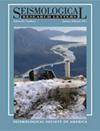A New Statistical Perspective on Båth’s Law
IF 3.2
3区 地球科学
Q2 GEOCHEMISTRY & GEOPHYSICS
引用次数: 0
Abstract
Abstract The empirical Båth’s law states that the average magnitude difference (ΔM) between a mainshock and its strongest aftershock is ∼1.2, independent of the size of the mainshock. Although this observation can generally be explained by a scaling of aftershock productivity with mainshock magnitude in combination with a Gutenberg–Richter frequency–magnitude distribution, estimates of ΔM may be preferable because they are directly related to the most interesting information, namely the magnitudes of the main events, without relying on assumptions. However, a major challenge in calculating this value is the bias introduced by missing data points when the strongest aftershock is below the observed cut-off magnitude. Ignoring missing values leads to a systematic error because the data points removed are those with particularly large magnitude differences ΔM. The error can be minimized by restricting the statistics to mainshocks that are at least 2 magnitude units above the cutoff, but then the sample size is strongly reduced. This work provides an innovative approach for modeling ΔM by adapting methods for time-to-event data, which often suffer from incomplete observations (censoring). In doing so, we adequately account for unobserved values and estimate a fully parametric distribution of the magnitude differences ΔM for mainshocks in a global earthquake catalog. Our results suggest that magnitude differences are best modeled by the Gompertz distribution and that larger ΔM are expected at increasing depths and higher heat flows.巴巴斯定律的统计新视角
经验巴斯定律指出,主震与其最强余震之间的平均震级差(ΔM)为~ 1.2,与主震的大小无关。虽然这一观察结果通常可以用余震强度与主震震级结合古登堡-里希特频率-震级分布的比例来解释,但ΔM的估计可能更可取,因为它们与最有趣的信息直接相关,即主要事件的震级,而不依赖于假设。然而,计算该值的一个主要挑战是,当最强余震低于观测到的截止震级时,由于缺少数据点而引起的偏差。忽略缺失值会导致系统错误,因为被删除的数据点是那些具有特别大的幅度差异ΔM。误差可以通过将统计数据限制在截止点以上至少2个震级单位的主震来最小化,但这样就大大减少了样本量。这项工作提供了一种创新的方法,通过适应时间到事件数据的方法来建模ΔM,这些数据经常受到不完整观察(审查)的影响。在这样做的过程中,我们充分考虑了未观测到的值,并估计了全球地震目录中主震震级差异ΔM的完全参数分布。我们的结果表明,震级差异最好用Gompertz分布来模拟,并且随着深度的增加和热流的增加,预计会有更大的ΔM。
本文章由计算机程序翻译,如有差异,请以英文原文为准。
求助全文
约1分钟内获得全文
求助全文
来源期刊

Seismological Research Letters
地学-地球化学与地球物理
CiteScore
6.60
自引率
12.10%
发文量
239
审稿时长
3 months
期刊介绍:
Information not localized
 求助内容:
求助内容: 应助结果提醒方式:
应助结果提醒方式:


